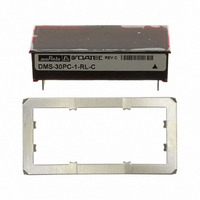DMS-30PC-1-RL-C Murata Power Solutions Inc, DMS-30PC-1-RL-C Datasheet - Page 3

DMS-30PC-1-RL-C
Manufacturer Part Number
DMS-30PC-1-RL-C
Description
DPM LED MINI 2VDC 3.5DIG LP RED
Manufacturer
Murata Power Solutions Inc
Type
Voltmeterr
Series
DMS-30PCr
Datasheet
1.DMS-30PC-1-GS-C.pdf
(6 pages)
Specifications of DMS-30PC-1-RL-C
Display Type
LED
Measuring Range
±2V
Display Style
Red Characters, Black Background
Display Face Size
2.09" L x 0.84" W (53.1 x 21.3mm)
Display Digits
3.5
Display Digits - Height
0.560" (14.22mm)
Backlight
Without
Mounting Type
Panel Mount
Termination
PC Pins
Voltage - Supply
4.75 ~ 5.25V
Equipment Type
3 1/2 Digit, LED Display Low-Power
Input
+/- 2 V
Lead Free Status / RoHS Status
Lead free / RoHS Compliant
Lead Free Status / RoHS Status
Lead free / RoHS Compliant, Lead free / RoHS Compliant
Other names
811-1023
4. DISPLAY TEST (Pin 2): Connecting pin 2 to +5V SUPPLY (pin 1) will
5. Decimal Point Placement: The location of the decimal point is
6. Gain Adjust: There is a gain-adjust potentiometer on the back of
7. Soldering Methods: All models in the DMS-30PC Series easily
8. Suggested Mating Connectors:
activate all LED segments, except the decimal points, and the display
will read "1888" regardless of the actual applied input. If a negative
input is applied, DISPLAY TEST will also activate the minus sign. To
protect the LED's, the display should not be left in the "test" mode for
more than 10 seconds.
user-selectable, and the decimal point control pins (DP1-DP3) are
active low functions. Select the desired decimal point by tying the
appropriate pin (pin 4, 5 or 6) to pin 3 (5V RETURN). Unused decimal
point location pins should be left open.
Hard wiring is preferable, however, you can use logic gates to
exercise dynamic control over the location of the decimal point if the
following drive conditions are met:
each meter. It has approximately ±50 counts (±2.5%) of adjustment
range. Since these devices essentially have no zero/offset errors,
a gain adjustment is effectively an overall accuracy adjustment.
Though they may be performed at any point (except zero), accuracy
adjustments are most effective when performed with higher level
input signals. The circuit shown in Figure 10 provides ±10% range of
adjustment.
withstand most common wave soldering operations. We recom-
mend, however, that you evaluate the effects your particular soldering
techniques may have on the meter's plastic case and high-precision
electrical performance. We recommend the use of no-clean solders.
Panel mounted:
Board mounted:
Model
All Others
* The driving gates must be able to sink this much current
DMS-30PC-X-RL
(I
OL
) with a logic "0" output.
Connector housing
Terminal type
Crimping tool
Wire size
Insulation diameter
Stripping length
Socket
Applied "0" Voltage Load Current*
+0.05V max.
+0.4V max.
DATEL P/N 4320-01069-0
DATEL P/N 4400-01032-0
DATEL P/N 39-2099000
22 to 26 AWG
0.062" (1.57mm) maximum
0.100 to 0.125" (2.54 to 3.17mm)
DATEL P/N 4320-01074-0
www.murata-ps.com/dpm
0.7mA max.
6mA max.
1. Single-Ended Input Confi gurations: True single-ended measure-
APPLICATIONS
85-264Vac
DMS-30PC meters are highly versatile devices that can be used in
hundreds of applications. The application circuits chosen for this sec-
tion have historically received many inquiries. Every attempt has been
made to ensure technical accuracy, and all of the following circuits
have been prototyped and tested to ensure functionality. Please keep
in mind, however, that real-world applications are seldom as straight-
forward as the approaches presented here. Most applications have
many more components — and many more connections — than the
illustrations show.
The simplifi ed schematic shown in Figure 1 can be very useful when
debugging a malfunctioning panel meter circuit, particularly if the
user has some knowledge of operational amplifi ers (op amps). The
meter's high-impedance input consists of an op amp powered from a
±5Vdc power supply (the –5V is internally generated). Knowing this,
one can easily see why input signals applied to (–) INPUT LO and (+)
INPUT HI have to be kept within the power supply rails of ±5V. Also
note that only pin 11 has a current-limiting 909kΩ series resis-
tor. High input voltages that have a common ground with pin 3 (5V
RETURN) should only be applied to pin 11 ((+) INPUT HI) and never to
pin 12. In these high-voltage cases, pin 12 should always be tied to
pin 3 (5V RETURN).
One of the simplifi ed schematic's noteworthy features is that it
shows internal voltage values. It also shows that pin 3 is the meter's
zero-volt reference point — regardless of the type of power or signal
source used. This is an important point to keep in mind when a digital
or analog multimeter is used to make system measurements. The
multimeter's negative lead (usually the black one) must be connected
to pin 3 (5V RETURN).
ments can be made with any DMS-30PC meter. The circuit of Figure
2 avoids problems normally associated with ground-loop currents.
Separate ground runs should be used for 5V RETURN (pin 3) and (–)
INPUT LO (pin 12). This will ensure that large LED currents will not
fl ow in the wiring that connects V
loop currents can cause unstable readings.
+
–
V
IN
AC to DC Converter
Technical enquiries email: sales@murata-ps.com, tel:
(–) IN LO
Figure 2. Single-Ended Input Confi guration
(+) IN HI
3½ Digit, LED Display Low-Power,
Miniature Digital Panel Voltmeters
11
12
+5V SUP
DMS-30PC Series
1
IN
DMS-30PC-1
to (–) INPUT LO (pin 12). Ground-
MPM_DMS_30PC.F05 Page 3 of 6
6
DP1
3
5V RET
+1 508 339 3000
8
REF OUT
7
REF IN





